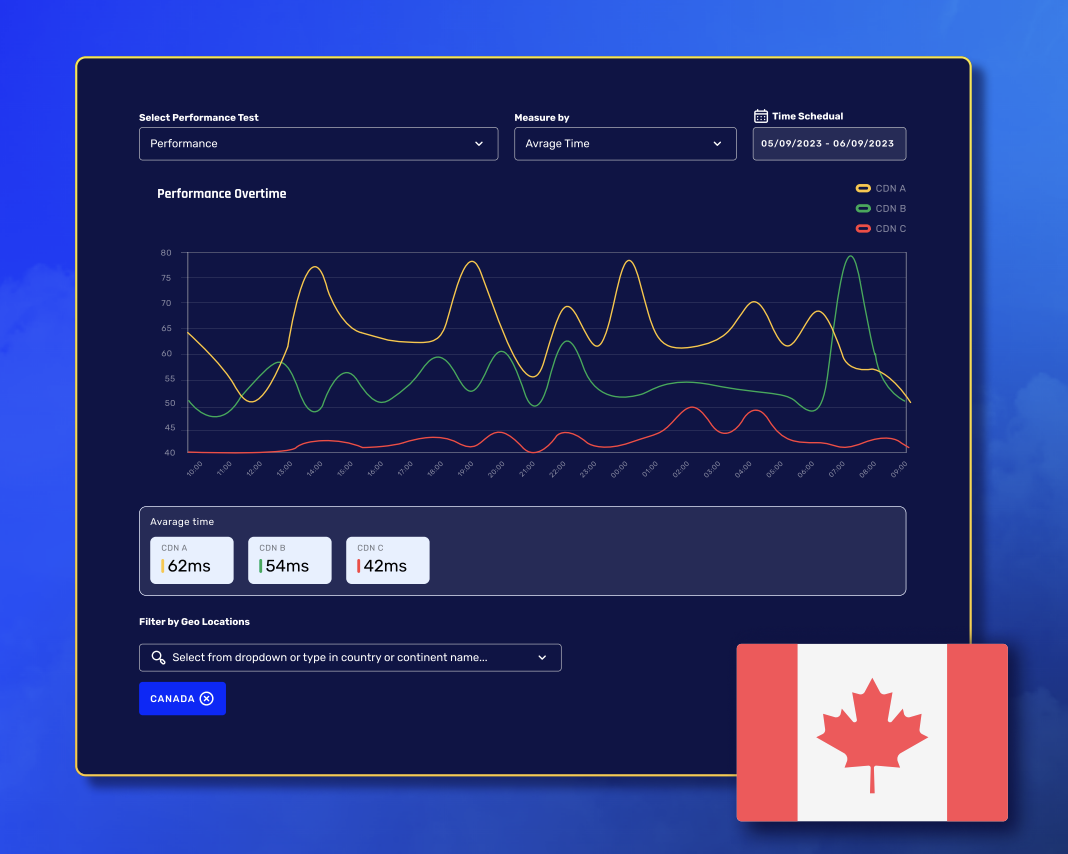The Importance of Network Traffic Control (NTC) in a Multi-CDN World
Online business is about user experiences, continuously building on elements. But your server can only handle so many experiences without lowering performance. Enter Network Traffic Control, particularly in multi-CDN (Content Delivery Network) environments. This process is like directing traffic in a busy city, but instead of cars, it's about handling the flow of information. It's important because it helps websites load fast and work well, even when many use them. This control also involves smart decisions about cost, where users are, and keeping services running smoothly all the time. So, in this article, let’s explore how Network Traffic Control (NTC) in a multi-CDN setup optimizes user experience and business efficiency.

Core Principles of Network Traffic Control
Network Traffic Control (NTC) is critical for optimizing user experience and business efficiency. The core principles of NTC involve strategic management of data flow across networks, ensuring that content delivery is both fast and reliable.

Traffic Prioritization and Management
This process is about intelligently categorizing and handling data packets to optimize network performance and user experience. It's a blend of technical strategies and policy-based controls that guide how data travels through the network.
At its core, this involves categorizing data packets based on their importance and urgency. This classification is necessary because not all data on a network is equal. For instance:
- High-Priority Traffic: This category includes data packets that require immediate attention and swift delivery. Examples include real-time video streaming, voice-over-IP (VoIP) calls, and critical business transactions. These types of data are time-sensitive and demand priority to ensure seamless, uninterrupted delivery.
- Lower-Priority Traffic: Certain data types can tolerate delays without significantly impacting user experience. This includes activities like email synchronization, file backups, or software updates. These are typically scheduled during off-peak hours or managed in a way that their slower processing doesn't disrupt critical services.
Prioritizing important traffic reduces the likelihood of bottlenecks and service interruptions, leading to more stable network performance. It also allows for better utilization of network resources, preventing wastage and ensuring that the network can handle large volumes of data without compromising on speed or quality.
Bandwidth Allocation
Effective Bandwidth Allocation is essential for maintaining the balance between available resources and network demands. NTC systems dynamically allocate bandwidth based on current network conditions and predefined policies.
In addition, they also:
- Continuously monitor network traffic to understand current demand. This real-time monitoring is important for making informed decisions about bandwidth allocation.
- Based on the observed traffic patterns, dynamically adjust the bandwidth. In periods of high demand, more bandwidth is allocated to ensure smooth data flow. Conversely, in low-demand scenarios, bandwidth allocation is reduced to conserve resources.
There are also pre-determined policies and procedures set in place that guide how bandwidth is allocated. These policies are based on various factors, including the type of traffic, time of day, and overall network priorities.
Modern NTC systems often incorporate automated protocols that adjust bandwidth allocation based on predefined rules. This automation ensures a swift response to changing network conditions without manual intervention
Geographical Considerations
In a multi-CDN setup, bandwidth allocation is also influenced by geographic considerations. More bandwidth might be allocated to regions experiencing high traffic volumes, ensuring uniform service quality across different locations.
Bandwidth is distributed across various CDNs to balance the load. This prevents any single CDN or server from becoming a bottleneck, thereby enhancing overall network performance.
{{promo}}
Quality of Service (QoS)
Quality of Service (QoS) is a key principle in NTC, focusing on delivering a consistent and high-quality user experience. At the heart of QoS is the prioritization of network traffic. This involves classifying network traffic based on its importance and ensuring that critical data packets, such as those for live streaming or essential business operations, are transmitted first.
QoS involves allocating bandwidth effectively to prevent network congestion. This includes dynamically adjusting bandwidth allocation based on the current network load and the priority of the data being transmitted. Effective bandwidth management ensures that high-priority tasks have the necessary resources, especially during peak traffic periods.
These strategies aim to reduce packet loss (where data packets are lost during transmission) and latency (the delay before a transfer of data begins following an instruction). These two factors are critical in determining the quality of the user experience, especially in real-time applications like video conferencing or online gaming.
Implementing QoS in Multi-CDN Environments
- Cross-Network Coordination: In a multi-CDN setup, it's essential to have coordination across different networks and servers. QoS settings need to be synchronized across these networks to ensure consistent performance regardless of the path data takes.
- Adaptive Strategies: Due to the varying nature of network traffic and user demands, QoS must be adaptive. This includes using intelligent algorithms that can respond in real-time to changes in network conditions, adjusting priorities and bandwidth allocation as needed.
- User-Centric Approach: The ultimate goal of QoS is to enhance the user experience. This means that QoS strategies should be designed with the end-user in mind, ensuring that the performance they experience is consistent and reliable, irrespective of their geographical location or the specific CDN they are connected to.
Challenges in Network Traffic Management

You need to be effectively managing these aspects in order to ensure the smooth operation of your network traffic control systems. On the forefront, it might seem like a big hassle, but the benefits are well worth it, especially when it comes to enhancing user experience.
1. Handling of Failures
One of the primary challenges in network traffic management is the effective handling of failures. In a multi-CDN environment, failures can occur due to various reasons like hardware malfunctions, software bugs, or network congestion.
Ensuring high availability and resilience involves implementing robust failover mechanisms and redundancy protocols.
This includes automatic rerouting of traffic to healthy servers and CDNs during outages, as well as regular system checks and maintenance to preemptively identify and rectify potential failure points.
2. Managing High-volume and Diverse Traffic
The ability to manage high volumes of traffic, which can be highly diverse in nature, is another significant challenge. As online services expand, the volume of data being transferred over networks increases exponentially.
This traffic comprises various types of content, from streaming media to large data transfers, each with different bandwidth and latency requirements.
Efficient traffic management in such scenarios requires sophisticated algorithms and tools capable of analyzing traffic patterns, predicting peak load times, and dynamically adjusting resource allocation to maintain optimal performance.
3. Security and Compliance Concerns
Security and compliance are paramount in network traffic management, particularly with the increasing prevalence of cyber threats and stringent regulatory requirements. Protecting sensitive data from unauthorized access and cyber-attacks while ensuring compliance with data protection regulations like GDPR or HIPAA is a continuous challenge.
This necessitates the implementation of advanced security protocols, regular security audits, and ensuring that all components of the network adhere to the latest compliance standards.
The complexity increases in a multi-CDN setup as data traverses multiple networks and jurisdictions, requiring a comprehensive and cohesive security strategy.
{{promo}}
Web Traffic Control
Web Traffic Control refers to the strategies and technologies used to manage the flow of data across the internet, particularly for websites and online services. This process is vital for ensuring that websites remain accessible, efficient, and secure, especially under varying load conditions.
With the increasing reliance on online platforms for business, entertainment, and communication, effective Web Traffic Control has become a cornerstone of digital operations.
DNS
The Domain Name System (DNS) serves as the internet's phone book. It translates human-friendly domain names (like www.example.com) into IP addresses that computers use to identify each other on the network.
In Network Traffic Control, DNS manages traffic flow, ensuring efficient and reliable access to websites and online services.
- Traffic Routing and Load Balancing: DNS directs users to the optimal server, often based on geographic location, which helps in balancing load across multiple servers and reducing latency.
- Failover Mechanisms: In case of server downtimes or outages, DNS can reroute traffic to alternative servers, ensuring continuous website availability and minimizing disruptions to user access.
CDNs
Content Delivery Networks (CDNs) play a significant role in enhancing the performance and reliability of online content delivery. They are especially crucial in the broader context of Network Traffic Control, where managing web traffic efficiently across different geographical locations is vital.
- Content Distribution and Caching: CDNs store cached versions of web content in multiple geographic locations. This helps in delivering content from the nearest server to the user, reducing latency and speeding up access.
- Load Balancing Across Servers: By distributing traffic across various servers, CDNs effectively balance the load. This prevents any single server from being overwhelmed, enhancing overall network stability and resilience.
- Reduced Bandwidth Consumption: By serving content from locations closer to the user, CDNs reduce the amount of data that needs to travel across the internet. This leads to lower bandwidth usage and reduced costs, especially for data-intensive content like videos and large images.
- Enhanced Security: CDNs offer additional security layers to protect against cyber threats such as DDoS attacks. They can absorb and distribute the traffic load during such attacks, mitigating their impact.
- Improved Website Performance and Reliability: By leveraging global server networks, CDNs ensure that websites remain accessible and performant even during traffic spikes or server outages in one region.
Origins
"Origins" refer to the original servers where website content is stored and managed. They are the primary source of data and content that is distributed across the internet. Key aspects of origins include:
- Primary Data Source: Origins serve as the central repository for a website's content, including HTML files, images, videos, and scripts. They are the starting point for content distribution across various channels and networks.
- Content Synchronization: In multi-server environments, Origins ensure that all distributed servers or CDNs have the latest and synchronized version of content. This is crucial for maintaining consistency and accuracy of information presented to users.
- Load Management: While CDNs handle a significant portion of user requests, Origins play a key role in managing overall load. They handle requests that are not cached or distributed by CDNs, especially for dynamic content that requires real-time processing or database interaction.
- Security and Control: Origins are critical from a security standpoint. They are fortified with various security measures to protect the website's core data from cyber threats. Additionally, having control over the Origin allows for more stringent and specific security protocols tailored to the website's unique requirements.
- Performance Optimization: Efficient management of Origins is key to optimizing website performance. This includes server maintenance, application optimizations, and ensuring high availability to handle direct requests effectively.
- Backup and Recovery: Origins often serve as the primary point for backup and disaster recovery plans. In case of failures in the distributed network, the Origin can be used to restore content and services, ensuring business continuity.
Impact of Multi-CDN on Traffic Control

The implementation of a multi-Content Delivery Network (CDN) strategy affects various aspects of how content is delivered and managed over the internet.
Multi-CDN environments offer enhanced performance, reliability, and scalability, but they also introduce unique challenges in traffic management.
Advantages: Redundancy and Handling Local and Global CDN Outages
The implementation of a multi-CDN strategy brings substantial advantages, particularly in terms of redundancy and handling both local and global CDN outages.
1. Enhanced Redundancy
Redundancy is one of the primary benefits of a multi-CDN setup. By distributing content across multiple CDNs, there is no single point of failure. If one CDN experiences downtime, traffic can be automatically rerouted to another CDN without impacting end-users.
This redundancy is crucial for businesses that demand high availability, such as e-commerce platforms, streaming services, and online gaming.
2. Improved Handling of Local CDN Outages
Local CDN outages, caused by regional issues such as network disruptions, hardware failures, or local disasters, can significantly impact content delivery in that area. In a multi-CDN environment, other CDNs can take over the load, ensuring that users in the affected region still have access to content.
This ability to compensate for local outages enhances the reliability of service, particularly for businesses with a global user base.
3. Mitigation of Global CDN Outages
While global CDN outages are less common, they can have a more widespread impact. In a multi-CDN strategy, the risk associated with global outages is greatly reduced.
Traffic can be redistributed among the remaining operational CDNs, minimizing the disruption.
4. Load Balancing and Optimal Performance
Multi-CDN setups enable more effective load balancing. By dynamically shifting traffic between CDNs based on performance and availability, users can always be served from the optimal source.
This not only helps in handling outages but also ensures the best possible performance during normal operations, as traffic is always routed through the most efficient path.
5. Geographic Redundancy
Geographic redundancy is another advantage. Different CDNs may have stronger network presences in certain areas.
In case of a local outage, a multi-CDN approach ensures that another CDN with a strong presence in the region can take over, providing uninterrupted service to users in that geographic location.
Challenges: Complex Traffic Management to Origins
One of the primary challenges is the coordination between multiple CDNs and the origin servers. Each CDN may have different methods of caching and delivering content, requiring the origin server to be configured appropriately for each one.
This complexity increases when updates or changes are made to the content, as they must be simultaneously propagated across all CDNs to ensure consistency. Each CDN provider may use different technologies and offer different interfaces for managing traffic and content.
Similarly, gathering and analyzing data from multiple CDNs to make informed traffic management decisions is also very complex. It involves aggregating performance metrics, user data, and cost information from each CDN and then analyzing it to understand traffic patterns, identify issues, and make strategic adjustments.
Solution: IO River’s VirtualEdge Platforms

With VirtualEdge, the process of updating and propagating content changes across all CDNs is streamlined. It integrates seamlessly with various CDN technologies, offering a unified interface that simplifies traffic and content management. This unified approach is particularly beneficial when dealing with multiple CDNs that have their own unique interfaces and methods.
Moreover, VirtualEdge excels in aggregating and analyzing data from all the CDNs. It collects performance metrics, user data, and cost information, and synthesizes this data to provide a comprehensive understanding of traffic patterns.
The platform’s strength lies in its ability to unify disparate CDN technologies, ensuring consistent content delivery and efficient traffic management.
Conclusion
In conclusion, Network Traffic Control (NTC) in a multi-CDN environment ensures efficient data flow, high-quality service, and robust network management. Key aspects like traffic prioritization, bandwidth allocation, and Quality of Service (QoS) form the backbone of effective NTC, addressing challenges such as failure handling, traffic diversity, and security.







.webp)

